No. 23. Reports of Asst. Surg. Charles Smart, U. S. Army, Medical Inspector, of operations March 1-April 30.1
HDQRS. SECOND ARMY CORPS, ARMY OF THE POTOMAC,
March 31, 1865.
COLONEL:
The battle and movement that took place toward the termination of this month prevented me from holding the customary inspection of regimental camps and from rendering my report according to the prescribed form.
During the greater part of the month of March the corps lay in camp in rear of the line of works stretching from Fort Cummings to Hatcher’s Run at the Vaughan crossing. As the nature of this ground and formation of camps are specified particularly in my report for last month, I will here indicate only the measures taken in order to effect improvements in the condition of those commands mentioned as having been unhealthily situated.
The camping ground of the Second Brigade, Second Division, the swamp bordering the run at the Vaughan road, was considerably altered for the better, although the difficulties in the way of draining were very great, on account of the basin-like formation of the surface. Free trenching and active police, however, did very much.
In the case of the camp occupied by the Eight New York Heavy Artillery it was found impossible to effect any satisfactory alternation, and hence a removal form the location became necessary. Permission to this end was readily obtained from the major-general commanding, and the camp was removed some distance to the rear of its original position. In settling anew this regiment built log huts of the usual style, but the other regiments in the brigade continued to occupy the company barracks or shelter-tent covered stockades referred to in my last report.
The number of sick treated by the officers of the corps is expressed below:
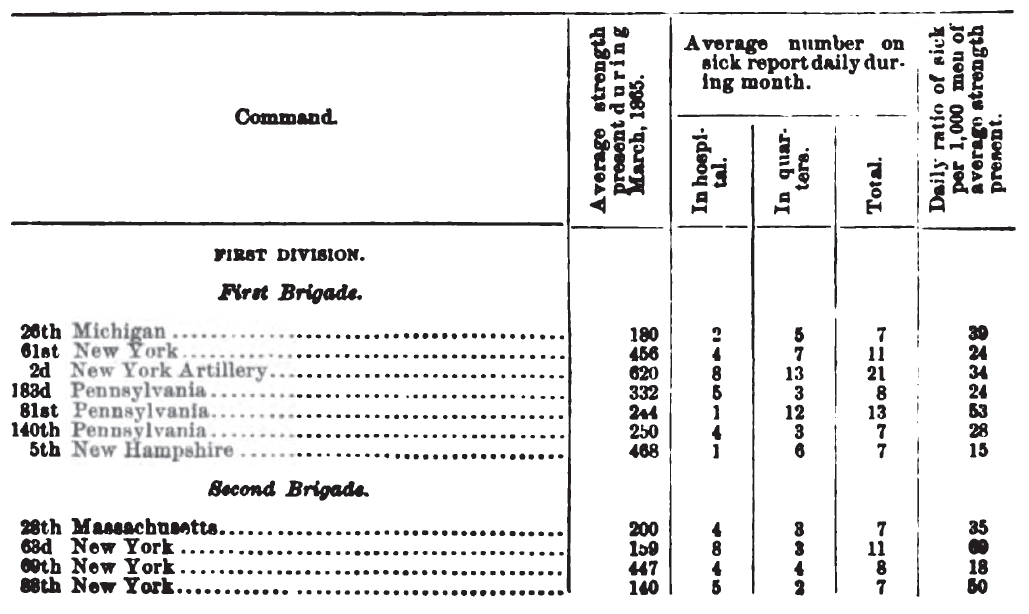
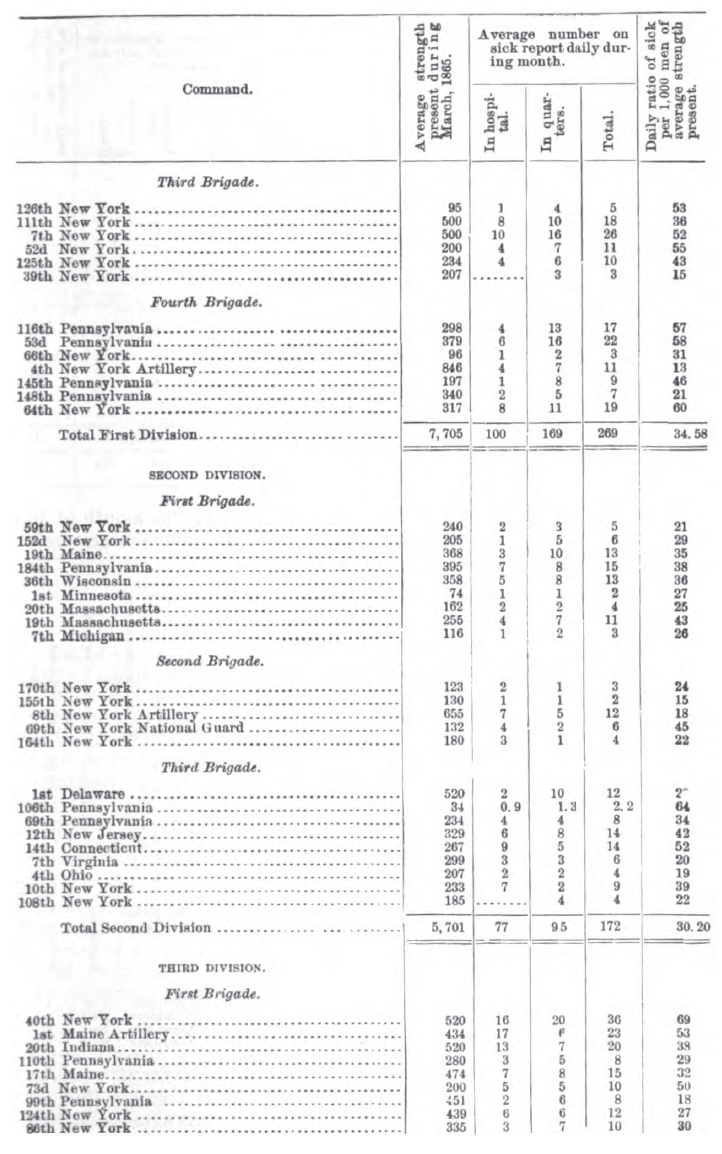

The field division hospitals were situated during the month at Patrick’s Station. The following give their constitution immediately before the commencement of the campaign:
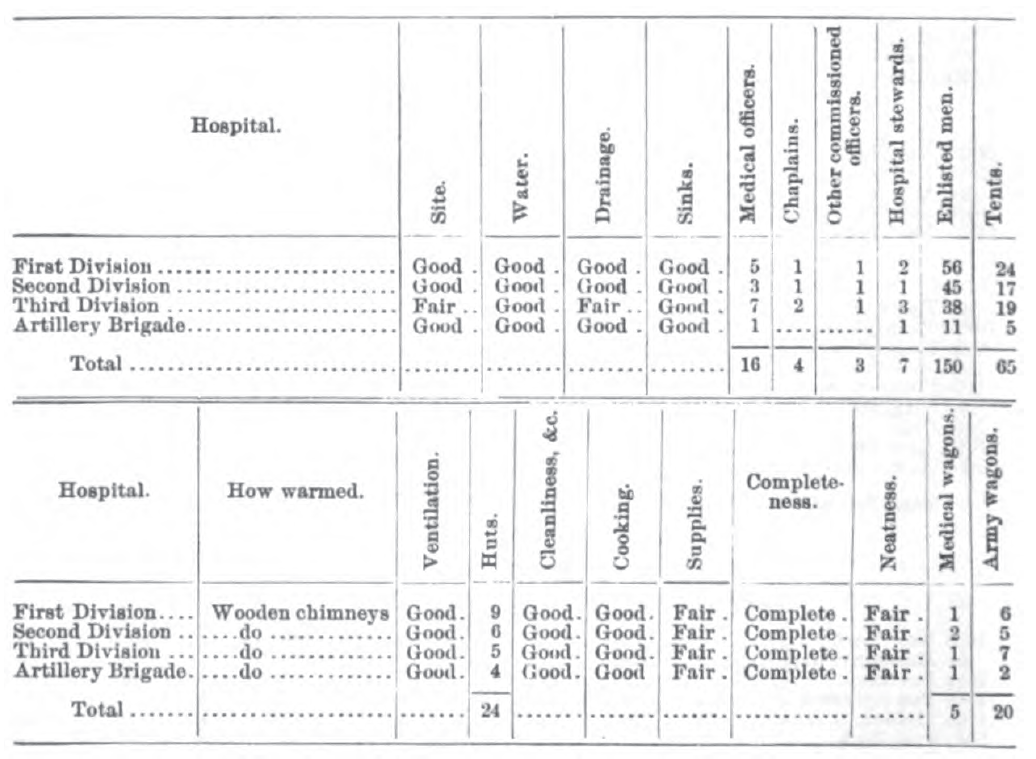
The following is report of sick and wounded treated in the field hospitals during the month:
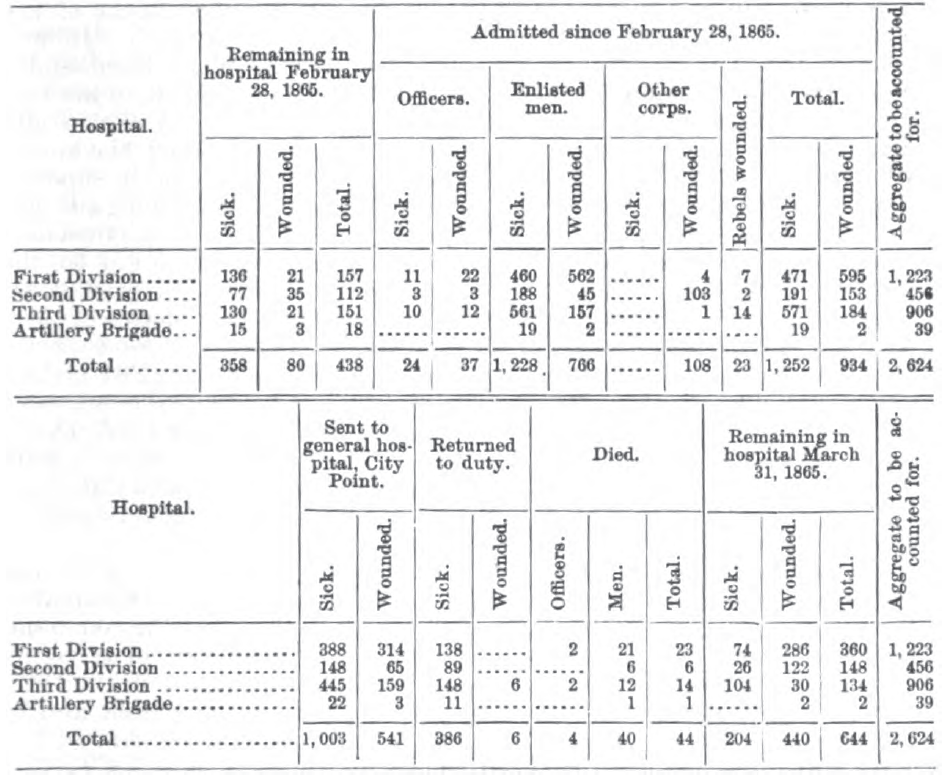
Early in the month, in expectation of the commencement of the spring campaign, the medical wagons belonging to the hospitals, those of brigades, and the boxes of the ambulances were well stocked with field supplies drawn form the purveyor at City Point. The surgeons-in-chief of the Second and Third Divisions, in view of the recurrence of such actions as Reams’ Station and Boydton road, where, while the engagement was in progress, all the medicine wagons were by order lying in park many miles in rear, had recourse to a plan by which they would be enabled to render themselves for a short time independent of the contents of their Autenrieth and Perot wagons. They caused the boxes of two of their ambulances to be filled not with the beef stock, hard bread, &c., directed by the supply table, but with battle supplies, chloroform,morphine, lint, plaster, rollers, and whisky. The ambulances so loaded were marked, and the ambulance officer directed that whenever a movement was ordered in which a portion only of the hospital train was permitted to participate these ambulances should be of the accompanying portion.
About this time, also, a diminution in the amount of transportation allowed the department was ordered to the extent of depriving he corps of seven wagons-reducing the number from forty-four to thirty-seven. Of these thirty only were available for carrying hospital and the ambulance train. In order the better to accommodate the amount to be carried to the diminished means of transportation everything of questionable utility during a campaign was turned in to the purveyor.
As a further preparation for anticipated active operations an application was made b the acting medical director to have the drummers and musicians of the command report at the commencement of the campaign to the surgeon in charge of the field hospital. It was acceded to. The surgeon in charge was directed to place them under command of the commissioned combatant officer attached to his hospital, who, with the assistance of two or three non-commissioned officers, was expected to keep up an efficient discipline among them, and when work of any description was to be performed by them to superintend its performance. During the campaign of 1864 although it was expected that during an engagement drummer boys and musicians would report to the hospital for duty, only a few of them did so, the majority straggling over the country and doing as they pleased, there being none to exercise any authority over them, to take notice of their absence and punish them for it; and the services of those that did report were of no value, since no one was specially intrusted with their direction. In fact they were looked upon rather as an incumbrance than as affording any assistance. those belonging to the First Division, however, were in a measure organized and disciplined, and were found to be useful in proportion as they were so, doing guard duty, and in time of need rendering very effective service as stretcher-carriers. This led to the application for the order at this time.
On the 14th instant a telegram from headquarters, Army of the Potomac, medical director’s office, directed the immediate removal to the depot, at City Point, of all those unable to accompany the command on a march, and that in future the hospitals should be kept in as mobile a condition as possible. In accordance with these orders, on the 15th, 16th, and 17th instants, there were sent to the rear 779 sick and 71 wounded; of the sick a large proportion were trivial cases that within a few days were returned from the depot to their regiments for duty.
Very early on the morning of the 25th instant the enemy assaulted, captured, and were driven out of Fort Stedman, on the right of the Petersburg front. At 7 a. m. the Second Corps was placed under arms and ordered to expect marching orders at any moment. The idea that prevailed was that the corps would be called upon to move off to the right to aid in repairing the mischief effected by the enemy there, for thought the news of the surprise was known to us that of the subsequent success of the Ninth Corps had not reaches us. At 9 a. m. the corps was moved out of the fortifications and advanced in line of battle westward for fully a mile, until the works of the enemy were discovered; a brigade of the Third Division was sent forward to charge the first line of picket pits. This they did, losing but very few men in the assault. The wounded were speedily conveyed to Patrick’s Station, where a couple of tents were pitched to accommodate them. Nothing of any moment occurred after this until about midday; an active picket shooting, it is true, was kept up, but the casualties were very few. At noon a second attack was made by the Third Division upon another line of rifle-pits; it was equally a success. After this the picket shooting became particularly sharp and continued so during the afternoon until 4.15, when the enemy, having massed Mahone’s division in Miles’ (First Division) front, assaulted his line with great vigor, but unsuccessfully. The fighting was very sharp and confined at first for the most part to that portion of the line held by the Irish Brigade (Second), but it gradually extended toward the left, implicating the whole of the Third Division and one or two regiments on the right of the Second.
General Griffin’s division (First), of Fifth Corps, formed our support. The musketry continued with all its original activity for two hours, and it was past 8 p. m. before the enemy ceased to renew his attempts to break the line. During the course of the afternoon the Sixth Corps, on our right, assaulted the enemy’s entrenched picket-line.
As usual during an engagement the medical officers unattached to the division field hospitals reported at the point where the stretcher bearers of each brigade transferred the wounded to the ambulance wagons, giving such attention to the patients as was imperative before sending them to the rear. The ambulance corps worked zealously, and very shortly after the termination of the engagement had all the wounded lodged at Patrick’s Station. The hospitals had been re-established as soon as the musketry had indicated a line of battle fire; all the tents had been pitched and the operating staffs of the different tables had reported for duty. The surgeons in charge were instructed that their patients were required to be in condition to be moved to City Point by 10 a. m. of the morrow, and that immediately on their departure the establishments were again to be held in readiness for a sudden movement.
The casualties were as follows:
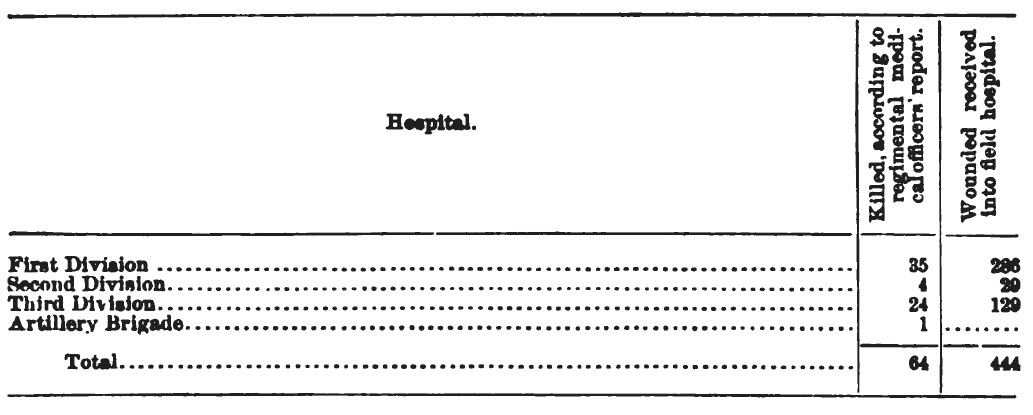
No casualties occurred in the medical or ambulance departments. Cars reported at Patrick’s Station at noon of the following day, and by 1 p. m. the wounded were all on their way to the depot at the point. All had been attended to, every operation deemed necessary performed, and every wound dressed before the departure of the train.
On the 26th the troops retired from the line of captured rifle-pits to within the fortifications, where they lay quietly until the morning of the 29th instant. On the 28th the command was again placed under marching orders; the sick and wounded, 142 in number, that had accumulated int eh hospitals were sent to the point, and the establishment at Patrick’s Station broken up and held in readiness to move after the troops.
Special requisitions filled by the medical purveyor had supplied the deficiencies caused by the fight on the 25th.
At 6 a. m. of the 29th the campaign was commenced, the Second Division moved across Hatcher’s Run, on the Vaughan road, and was followed by the Third and First. The forenoon was spent in perfecting the line of battle, making connection with the Fifth Corps on the left and on the right with the Twenty-fourth. The line extended east and west from the Quaker road to Hatcher’s Run, north of the Vaughan crossing, the First Division being on the left and the Second on the
right. In the afternoon, while the Fifth Corps engaged the enemy, our line was pushed forward for some distance without the development of any opposition.
On the following morning, notwithstanding the heavy rain-storm that continued without intermission during the whole of the day, the advance in line of battle was continued, through dense undergrowth and swamps, until the position was reached and entrenched, stretching from the Twenty-fourth Corps, on Hatcher’s Run, westward by J. Crow’s house, north of the Dabney Millroad, crossing that road about a quarter of a mile from its termination in the Boydton plank, and connecting with the right of the Fifth Corps at Mrs. Rainey’s in the angle formed by the junction of the Quaker or military and the Boydton roads. Mrs. Rainey’s house was that used as a field hospital during the corps’s engagement with the enemy on the 27th of October of last year.
In the order of march published for the morning of the 29th, it was directed that a medicine and an army wagon to each brigade and one-half of ambulances would be permitted to accompany the troops, and that each train should follow in rear of its division; but as the road was narrow, and a rapid movement into line of battle expected of the troops, which trains would possibly interfere with, the order was modified in so far as to direct the trains of the corps to remain on the left bank until all the direct the trains of the corps to remain on the left bank until all the troops and artillery had passed across. After the troops had assumed line of battle half a dozen ambulances were forwarded to the immediate rear of each division, while the hospital organization remained at the Cummings house, it being intended to form a hospital their should a fight take place on the line first assumed; but on the morning of the 30th the advance of the troops rendered a corresponding advance necessary on the part of the trains. They were accordingly moved over to the west side of the run, and parked to await events-the Second and Third Divisions at the “Chimneys” (the remains of a house), in an open space, where the road leading to Dabney’s Mill leaves the Vaughan road; and the First at a wooden building on the main road, between the “Chimney'” and the crossing over Gravelly Run.
Late on the evening of the 29th twenty of our ambulances were sent to the Fifth Corps field hospital to aid in conveying the wounded of that command to Humphreys’ Station.
On the succeeding day a number (about 100) of cavalrymen form Sheridan’s command were admitted into the Second Division hospital, dressed, and then conveyed across the run for railroad transportation to the Point. Very early on the morning of the 31st, as the enemy were discovered in heavy force in front of the Fifth Corps, the First Division of this command was moved to the left to their support, the Third and Second Divisions extending to the left, to occupy the vacated part of the line. The hospital of the First Division was directed to move forward form the Vaughan road to a clearance about half a mile distant form the Dabney Mill road, on the north, and the Quaker road, on the west. The communications between this clearance and the roads and between them and the front were very free. Immediately after the hospital train had reached this point, at noon, the division became heavily engaged, and at 2 p. m. the Third Division participated lightly. The wounded were brought off the field with great promptness. The hospital train of the Third Division, at midday, was ordered to move to some sport near the position occupied by the First, but it was close upon midnight before it succeeded in reaching this point. The Vaughan and wood roads were in miserable condition, on account
of the heavy rains of the previous day, and, in addition to this, they were blocked up by ammunition and other heavy wagons that had found them impassable until roughly corduroyed. The wounded of the Third Division, however, did not suffer in any degree from the want of the wagons. They were treated at the First Division hospital by the medical officers of their own division until the arrival of the train permitted them to form an establishment of their own.
The Second Division hospital remained at the Chimneys, as this position was still in rear, and near enough to the part of the line held by the troops in the command.
The casualties in this fight were recorded as follows:
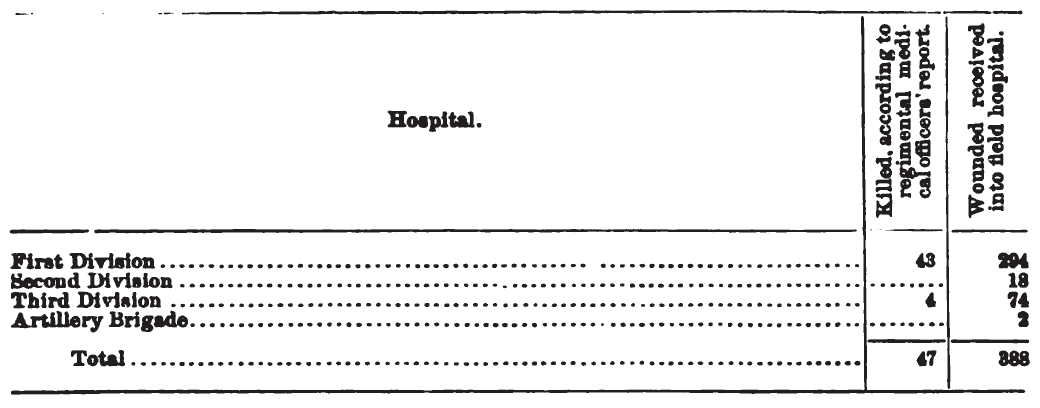
No casualties occurred in the medical or ambulance departments. In the afternoon arrangements were made for the transportation of the wounded to City Point. The medical officers were instructed to have all operations performed and every case attended to and ready for transmission to the rear by the following daybreak. The reserve train of ambulances, that which general orders on starting form the fortifications had prohibited us from taking with us, were sent for, in order to carry the wounded to Humphrey’s Station, where cars were expected to be ready for them at 9 a. m.
Respectfully submitted.
CHARLES SMART,
Asst. Surg., U. S. Army, Medical Inspector, Second Army Corps.
Surg. THOMAS A. McPARLIN,
Medical Direction, Army of the Potomac.
HEADQUARTERS SECOND ARMY CORPS,
April 30, 1865.
DOCTOR: At the commencement of this month the corps formed a line of battle stretching form Hatcher’s Run, on the right, westward past the Crow house, the Dabney Mill road, and the Rainey house, at the junction of the Quaker and Boydton roads, toward the White Oak road, where it connected with the Fifth Corps. the Second Division was on the right, the Third held the center, and the First the left. The hospitals were situated-the Second on the Vaugah road, near Hatcher’s Run, and the Third and First at a point some distance in rear of the angle formed by the Dabney Mill and Quaker roads. The wounded from the engagement of the 31st of March, as mentioned in the report for that month, were being operated on with all diligence, in order to have them in proper condition by daybreak of the 1st instant for transmission to Warren’s Station, where a train of cars was to be awaiting
them at 9 a. m. In order to transport them to the station the reserve half of the ambulances had been ordered up form the Cummings house, where they had been in park since the beginning of the campaign.
It was not, however, until about 10 o’clock on the morning of the 1st that they succeeded in reaching the field hospitals. They experienced much delay on account of the bottomless condition of the roads. By the time they arrived the wounded had all been properly cared for. They were immediately loaded up and dispatched for railroad transportation to the Point. In the meantime some changes were taking place in the position of the troops. The Fifty Corps moved off to the left toward the Five Forks, while this command extended toward the left to man the part of the line left unguarded by them. No fighting took place during the day, but toward evening and during the succeeding night the heavy cannonading and occasional musketry near Petersburg and at the Five Forks at times spread so as to engage the right and left of the corps line in the contest. At 8 a. m. of the 2nd instant an advance of part of the Third Division line was ordered, with the effect of driving the enemy form his advanced works, in the neighborhood of Burgess’ Mills, and, as was subsequently found, of causing an evacuation of the main line. No sooner was this discovered than the corps was started road, skirmishing very heavily with the enemy, so closely did it follow in their rear. The Third Division, on the left, moved toward the Cox road, skirmishing very heavily with the enemy, so closely did it follow in their rear. The Third Division advanced along the Boydton road toward Petersburg, near which it formed a line, connecting the left of division followed in rear of the troops, and was established at a suitable point on the road in rear of the battle line. The Second Division, accompanies by its field hospital, moved from the position in front of Dabney’s Mill to the Boydton road, and thence along the Cox road to First Division, which had here rested from the pursuit. the ambulances and hospital train of the First Division had followed the troops, carrying the wounded along as they picket them up until the train being loaded they were compelled to halt at a house, Moody’s, where a field hospital was formed. During the afternoon and evening the wounded from the division were carried to this place and underwent the necessary treatment. Two hundred and sixteen were received into this hospital, 8 into the Second, and 59 into the Third Division hospital; total received from the fight on April 2,283. Early on the morning of the 3rd, part of the reserve ambulances having returned from Warren’s Station, a train was formed to carry these cases to Petersburg for railroad transportation tot he depot at the Point. About the same time the Third Division joined the main body of the corps at Well’s Church, having vacated the position in front of Petersburg assumed during the p. m. of the previous day, and the whole command, in the order Third, First, and Second Divisions, followed by the hospital wagons, and a few ambulances that were not required to carry wounded to the city, moved westward along the Namozine road. The corps camped for the night near Namozine Church.
On the following morning the march was resumed, but before proceeding far two cavalry divisions, with their trains, blocked up the road in front, and impeded our progress. The corps camped on Deep Run. At midnight the troops were again on the move, and again cavalry and trains interfered with the advance. By 8 a. m. the road was clear and the corps pushed on toward Jetersville, which was reached early in the afternoon. A position was assumed on the left of the Fifth Corps, temporary works were thrown up and the men bivouacked.
Next morning (6th instant) the works were abandoned and an advance toward Amelia Court-House was commenced, in progress of which, near the Sulphur Springs, the rear of the enemy’s column was found. this changed the direction and manner of the march; line of battle was formed, and the enemy pursued through Deatonsville toward High Bridge, on the Appomattox. The rear of the enemy was engaged unremittingly until 8 p. m., when the corps bivouacked on Sailor’s Run, where a large portion of the rebel wagon and ambulance trains had been captured. The hospital of the First Division was established early in the day at Amelia Springs, those of the Second and Third Divisions at a house (Vaughan) about a mile from this. There were collected into the First Division sixty cases, into the Third Division hospital, 170; total, 230; but 25 of these were rebels and dozen Union cavalrymen. The Second Division had none wounded.
In the evening all the ambulances that could be spared from the advance reported to the surgeons in charge of hospitals, in order to carry as many as possible of the cases to Burke’s Station (Burkeville, Nottoway County), where a depot army hospital had been formed, but they were insufficient to carry all away. Medical department supplies were left with the cases that had to be left for the present at these field hospitals and suitable attendance and surgical skill provided them. No systematic assignment of commissary supplies was made to the surgeon detailed in charge, as most of his patients had more or less in their haversacks, and as both at the Springs and the Vaughan house there was a supply of corn meal, and fresh beef could be had for the shooting.
At High Bridge, on the following morning, the rear of the enemy was again struck, and skirmishing recommenced. Fighting continued with more or less activity until about 9 p. m., when the corps bivouacked near Farmville, on the right of the army-the Second Division on the right of the corps front, the First in the center, and the Third connecting with the right of the Sixth Corps. During the early part of this day’s running fight no hospitals were established, but the wounded were carried along after the advance until, when near Farmville, the enemy made a determined stand; then field hospitals were formed about one mile and a half in rear of the battle line, at the Brooks house. The cases received here numbered as follows: First Division, 150; Second Division, 24; Third Division, 35; total, 209. These were operated on during the night, and in the morning dispatched to the depot at Burkeville in a train, consisting of some Ninth Corps ambulances that had reported to aid the medical department of this corps, some captured rebel ambulances, and a few of those belonging to this command that could be spared from the front in view of the speedy return of those sent from Amelia Springs to the Junction on the previous day. In the meantime, the enemy having evacuated their Farmville defenses, the troops were advancing in pursuit through Buckingham County, but they did not overtake the enemy so as to engage him. at midnight they bivouacked about a mile west of New Store. After settling in camp for the night commissary started for the Vaughan house, to carry to Burke’s Station the sick and wounded left there on the afternoon of the 6th by the Third Division, but, as was afterward ascertained, these wagons were not required. Some ambulances belonging to the Ninth Army Corps had already picked them up and transported them to the depot.
On the 9th, although within striking distance of the enemy, no fighting took place, on account of the negotiations then in progress between the commanders of the two armies, which terminated, on the afternoon of that day, in the surrender of Lee’s forces. The campaign was over.
No casualties are reported in the medical department of the corps. In the ambulance corps one sergeant belonging to the First Division train was slightly wounded. The casualties during the month, according to reports rendered by regimental surgeons, were:
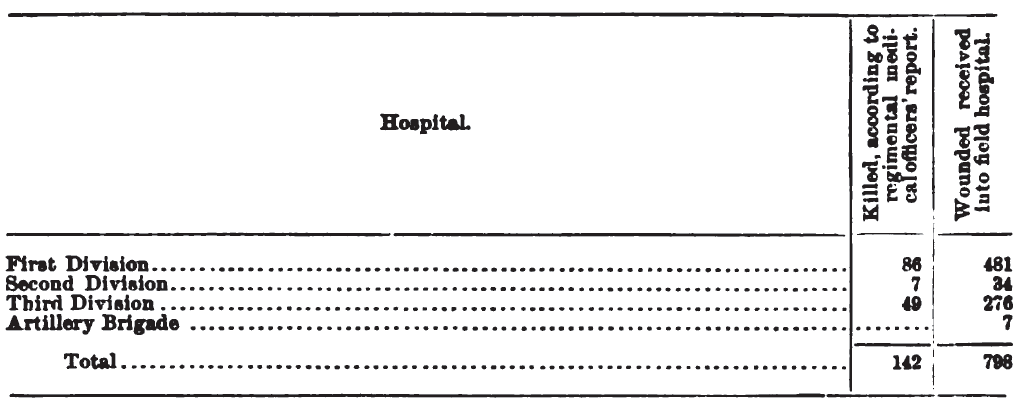
If to these be added the numbers yielded by the engagement of March 31 the losses of the corps during the campaign will figure:

No accidents occurred from chloroform administration during the month. On the 11th instant, as the troops were under orders to report to Burkeville, the few severe cases of sickness in the command were placed in ambulances and sent on ahead, that they might avoid the fatigue and the discomfort of the delays incident to transportation in rear of their commands. On the morning of the 12th the march was commenced, and on the afternoon of the 14th instant the crops went into camp in the angle formed by the Lynchburg road and that leading to Danville. The Third Division formed camp near the former road, the First near the latter, whole the Second occupied the center. The march to this place was not hurriedly effected, but it was very fatiguing to the men. The delays experienced on account of the bad character of the roads, the labor required to improve them, and the exposure to the rain, which fell almost unremittingly during the march, had considerable influence in inducing that increased sickness in the command which showed itself immediately after settling in camp. The men were quartered in shelter-tents, which they had raised from the ground on uprights about a foot and a half high. The bunk or bed place in each was likewise
—————
*But see revised table, p. 584.
—————
raised. Those regiments encamped in the open ground where there was no shade built arbors over their quarters for protection from the heat.
The First Division had an excellent location on an irregular ground, drained thoroughly well be nature; water was abundant and good. The soil on which the Second Division was settled was more retentive of moisture, but one that could have been well drained had the probability of a prolonged stay or the character of the weather rendered it necessary. Good water was scarce in this vicinity; the different regimental commands had dug wells, but the water obtained at no great distance from the surface was not clear, and, except when freshly drawn, had a surface-water taste. The Third Division was situated in a belt of woods; water was plentiful and good in the ravines. The division field hospitals were settled int he neighborhood of their commands upon good sites. The following represent their constitution at this time:

The following is a consolidated monthly report of sick and wounded treated in the field hospitals during April, 1865:

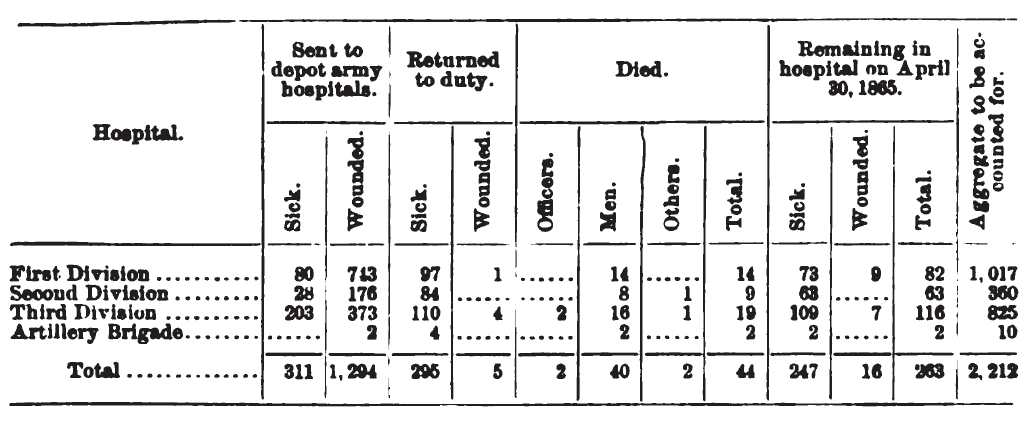
During the remainder of the month-that is, from the 14th instant-the sickness in the command experienced an increase, not so much in the number taken sick as int he gravity of the cases. the diarrhea, the prevailing disease, became very obstinate, and was accompanied with very great and rapidly increasing prostration, resembling the disease as seen during the Peninsular campaign of 1862. The fatigues of recent active service, the bad water in the Second Division, but more than all, I believe to be the origin of this, the lack of vegetables. Since camp near Hatcher’s Run was broken pu until the present time only one or two rations of potatoes have been issued, and none of any other vegetables, except to a portion of the command a small quantity of beans. this has been all, a quantity insufficient to prevent the occurrence of scorbutic symptoms. No “well-marked” cases of scurvy are recorder by the medical officers, except in one or two instances of men order of importance, was pneumonia. In the Second Division hospital a number of cases of measles were threaded. The disease was brought to camp by some recruits. Two cases of smallpox occurred, one having contracted the disease at City Point depot, the other at the Burkeville army hospital. They were immediately isolated, and are progressing favorably.
On the 20th instant a train of twelve ambulances was dispatched to Amelia Court-House with supplies for some wounded rebels quartered there, and to transport such of them as were in proper condition to endure it to the Farmville hospital. On the 29th the Confederate hospital at Farmville, under charge of Surg. O. J. Evans, Fortieth New York Volunteers, having been ordered to report to the medical director, Second Corps, a train of ambulances was sent in order to carry a hundred of the inmates that were so far recovered from their wounds as to be able to travel to their homes, which were reported to be in or near Petersburg, Va. They were brought to Burkeville and placed on the cars for the city. On the same night 3,000 rations were ordered out to supply the necessities of those still remaining in hospital, 650 in number, of whom twenty-seven were Union men unable to be removed on account of the character of their wounds.
The following represents the sick rate of the corps for the month of April. 1865:

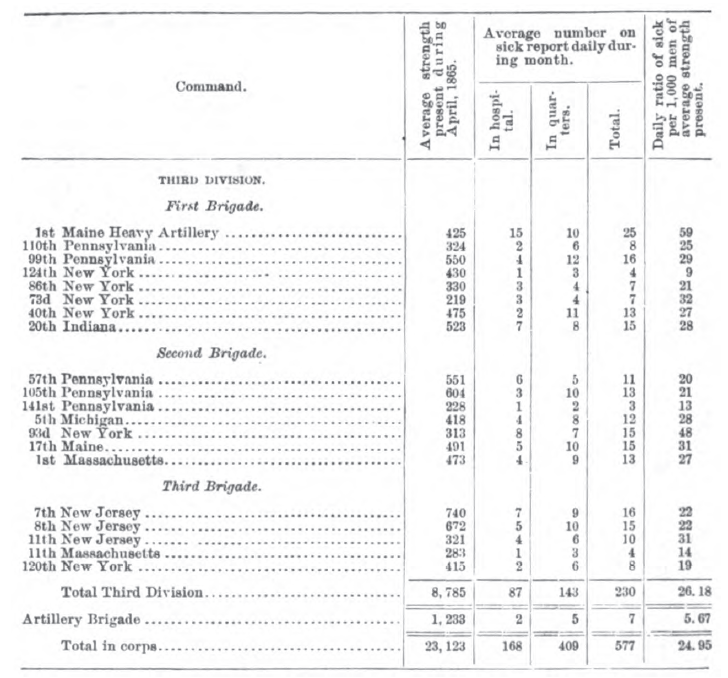
Respectfully submitted.
CHARLES SMART,
Asst. Surg., U. S. Army, Medical Inspector, Second Army Corps.
Surg. THOMAS A. McPARLIN, U. S. Army,
Colonel and Medical Director, Army of the Potomac.
Source:

